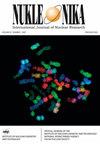Combination of methods of thermal and radiation treatment of sediments associated with PCBs – the Delor type
IF 0.3
4区 物理与天体物理
Q4 CHEMISTRY, INORGANIC & NUCLEAR
引用次数: 0
Abstract
Abstract An efficient method of burning polychlorinated biphenyls (PCBs) is often used to remove the environmental burden of PCBs. However, combustion produces toxic dioxins and furans (PCDD/F), so residents are increasingly rejecting this method. The heat treatment (HT) method does not burn PCBs but evaporates it from sediments. Even in this process, PCDD/Fs are formed to a lesser extent, which are destroyed by radiation processing (RP) following the HT. At the same time, the RP method degrades PCB congeners down to biphenyls, which decompose easily in the environment. A block assembly of a complex synergistic combination of equipment for methods of thermal (HT) and radiation (RP) destruction of PCBs in sediments is proposed. The efficacy of this complex was preliminarily determined at a level of 70-fold reduction in PCB concentration in sediments. To achieve a higher reduction factor in the concentration of PCBs, possible procedures for optimizing the settings of individual devices of this complex are presented.与多氯联苯有关的沉积物的热和辐射处理方法的组合- Delor类型
燃烧多氯联苯是消除多氯联苯环境负担的有效方法。然而,燃烧会产生有毒的二恶英和呋喃(PCDD/F),因此越来越多的居民拒绝这种方法。热处理(HT)方法不会燃烧多氯联苯,而是将其从沉积物中蒸发。即使在此过程中,PCDD/Fs的形成程度也较小,但会被高温后的辐射处理(RP)破坏。同时,RP法将PCB同系物降解为联苯,联苯在环境中容易分解。提出了一种用于沉积物中多氯联苯热(HT)和辐射(RP)破坏方法的复杂协同组合设备。在沉积物中PCB浓度降低70倍的水平上初步确定了该复合物的功效。为了在pcb浓度中实现更高的减少因子,提出了优化该复合体的单个器件设置的可能程序。
本文章由计算机程序翻译,如有差异,请以英文原文为准。
求助全文
约1分钟内获得全文
求助全文
来源期刊

Nukleonika
物理-无机化学与核化学
CiteScore
2.00
自引率
0.00%
发文量
5
审稿时长
4-8 weeks
期刊介绍:
"Nukleonika" is an international peer-reviewed, scientific journal publishing original top quality papers on fundamental, experimental, applied and theoretical aspects of nuclear sciences.
The fields of research include:
radiochemistry, radiation measurements, application of radionuclides in various branches of science and technology, chemistry of f-block elements, radiation chemistry, radiation physics, activation analysis, nuclear medicine, radiobiology, radiation safety, nuclear industrial electronics, environmental protection, radioactive wastes, nuclear technologies in material and process engineering, radioisotope diagnostic methods of engineering objects, nuclear physics, nuclear reactors and nuclear power, reactor physics, nuclear safety, fuel cycle, reactor calculations, nuclear chemical engineering, nuclear fusion, plasma physics etc.
 求助内容:
求助内容: 应助结果提醒方式:
应助结果提醒方式:


